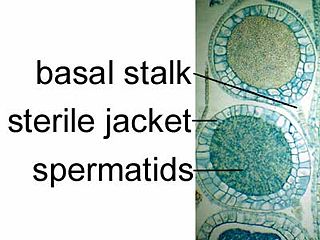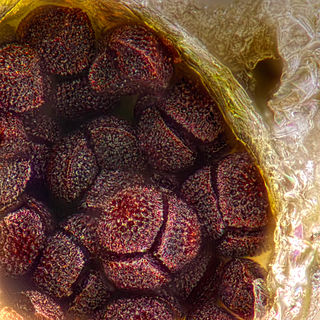Brachymeiosis was a hypothesized irregularity in the sexual reproduction of ascomycete fungi, a variant of meiosis following an "extra" karyogamy (nuclear fusion) step. The hypothesized process would have transformed four diploid nuclei into eight haploid ones. The current scientific consensus is that brachymeiosis does not occur in any fungi. [1]

Meiosis is a special type of cell division that reduces the chromosome number by half, creating four haploid cells, each genetically distinct from the parent cell that gave rise to them. This process occurs in all sexually reproducing single-celled and multicellular eukaryotes, including animals, plants, and fungi. Errors in meiosis resulting in aneuploidy are the leading known cause of miscarriage and the most frequent genetic cause of developmental disabilities.

Karyogamy is the final step in the process of fusing together two haploid eukaryotic cells, and refers specifically to the fusion of the two nuclei. Before karyogamy, each haploid cell has one complete copy of the organism's genome. In order for karyogamy to occur, the cell membrane and cytoplasm of each cell must fuse with the other in a process known as plasmogamy. Once within the joined cell membrane, the nuclei are referred to as pronuclei. Once the cell membranes, cytoplasm, and pronuclei fuse together, the resulting single cell is diploid, containing two copies of the genome. This diploid cell, called a zygote or zygospore can then enter meiosis, or continue to divide by mitosis. Mammalian fertilization uses a comparable process to combine haploid sperm and egg cells (gametes) to create a diploid fertilized egg.
Scientific consensus is the collective judgment, position, and opinion of the community of scientists in a particular field of study. Consensus implies general agreement, though not necessarily unanimity.
According to the current understanding, ascomycetes reproduce by forming male and female organs (antheridia/spermatia and ascogonia), transferring haploid nuclei from the antheridium to the ascogonium, and growing a dikaryotic ascus containing both nuclei. Karyogamy then occurs in the ascus to form a diploid nucleus, followed by meiosis and mitosis to form eight haploid nuclei in the ascospores. [2] In 1895, the botanist R.A. Harper reported the observation of a second karyogamy event in the ascogonium prior to ascogeny. This would imply the creation of a tetraploid nucleus in the ascus, rather than a diploid one; in order to produce the observed haploid ascospores, a second meiotic reduction in chromosome count would then be necessary. The second reduction was hypothesized to occur during the second or third mitotic division in the ascus, even though chromosome reduction does not typically occur during mitosis. This supposed form of meiosis was termed “brachymeiosis” in 1908 by H. C. I. Fraser. [3]

Ascomycota is a division or phylum of the kingdom Fungi that, together with the Basidiomycota, form the subkingdom Dikarya. Its members are commonly known as the sac fungi or ascomycetes. It is the largest phylum of Fungi, with over 64,000 species. The defining feature of this fungal group is the "ascus", a microscopic sexual structure in which nonmotile spores, called ascospores, are formed. However, some species of the Ascomycota are asexual, meaning that they do not have a sexual cycle and thus do not form asci or ascospores. Familiar examples of sac fungi include morels, truffles, brewer's yeast and baker's yeast, dead man's fingers, and cup fungi. The fungal symbionts in the majority of lichens such as Cladonia belong to the Ascomycota.

An antheridium is a haploid structure or organ producing and containing male gametes. The plural form is antheridia, and a structure containing one or more antheridia is called an androecium. "Androecium" is also used as the collective term for the stamens of flowering plants.

An ascus is the sexual spore-bearing cell produced in ascomycete fungi. Asci usually contain eight ascospores, produced by meiosis followed, in most species, by a mitotic cell division. However, asci in some genera or species can occur in numbers of one, two, four, or multiples of four. In a few cases, the ascospores can bud off conidia that may fill the asci with hundreds of conidia, or the ascospores may fragment, e.g. some Cordyceps, also filling the asci with smaller cells. Ascospores are nonmotile, usually single celled, but not infrequently may be coenocytic, and in some cases coenocytic in multiple planes. Mitotic divisions within the developing spores populate each resulting cell in septate ascospores with nuclei. The term ocular chamber, or oculus, refers to the epiplasm that is surrounded by the "bourrelet".
The existence of brachymeiosis was controversial throughout the first half of the twentieth century, with many conflicting results published. Then, research with improved staining techniques established clearly that only one reductive division occurs in the asci of all examined species, including some which had been believed to undergo brachymeiosis. [4] [5] As a result of these studies, the theories of double fusion and subsequent brachymeiosis were discarded around 1950. [1]









